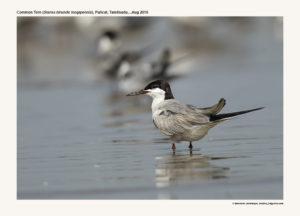Common Tern

Common Tern Sterna hirundo
Etymology:
- Sterna : Old English name “stearn” for terns , believed to be derived from Danish and Norwegian terne or Swedish tärna
- Hirundo : Latin word for Swallow
Vernacular Names: Guj: Pardeshidhomdi, Ladakhivabagali, Hindi: Samanyatehari, Mar: SamanyaSuray
Distribution in India: Breeds in Ladhak and widespread winter visitor to coastal India.
Description: Size of 32–39 cm; Wt. of 97–146 g; wingspan of 72–83 cm. It has a black forehead and crown; back and upperwings are grey; tail is white, with grey outer web to outer rectrices; underpartsare white with greyish wash, sometimes faintly suffused with pink early in breeding season; billis red with black tip; legs are red. The streamers of forked tail relatively short, not extending beyond wingtips at rest. In all plumages, but especially in summer and autumn, outer 5 primaries have conspicuous dark outer webs. The non-breeding adult has white forehead, crown is black with white streaks, and prominent dark bar on lesser coverts; underparts are greyish; bill is blackish, with red only at base; legs are duller red to blackish red. The juvenile is grey above, barred with dark grey or brown; blackish carpal bar on wing and dark secondary bar; bill is orange at base, soon becoming dusky grey-brown.
Habitat: It breeds in both coastal and inland areas, from sea-level to 4000+ m. It is found in sandy barrier beaches; vegetated inter-dune areas; sandy, rocky, shell or well vegetated islands in estuaries, lakes and rivers; grassy plateaux atop sea cliffs.
Food habits: It eats small fish, , crustaceans, insects and fish offal. It feeds in dense flocks over ocean, but some maintain individual feeding territories along shorelines. .It feeds mainly by plunge-diving, also by contact-dipping and aerial-dipping, and occasionally aerial hawking. Kleptoparasitism is common in some colonies or in conditions when food availability limited. It is often victimized by Skuas.
Breeding habits: They breed in April–June. .They breed on bare sand among moderate vegetation, rocks, or logs, but also uses open substrates with little or no vegetation; on beaches shows preference for nesting beside open area on margin of vegetation, and in marshes prefers edges of mats of dead vegetation, but occasionally on muskrat houses or on floating cattail mats; on rocky islets, prefers grassy to rocky substrates; readily nests on artificial rafts. The nest is a shallow depression, sometimes lined and/or with rim of stones, debris, etc., occasionally roofed over with vegetation; often placed near some vertical object such as rock, shell, plant or artifact, which may later provide shelter for chicks and may facilitate nest identification. The clutch and egg sizes depend on food availability.They lay a clutch of 2-3 eggs. The incubation period is 22–28 days. In extremely hot days, adults wet belly feathers to cool eggs. The fledging period is 24–28 days.